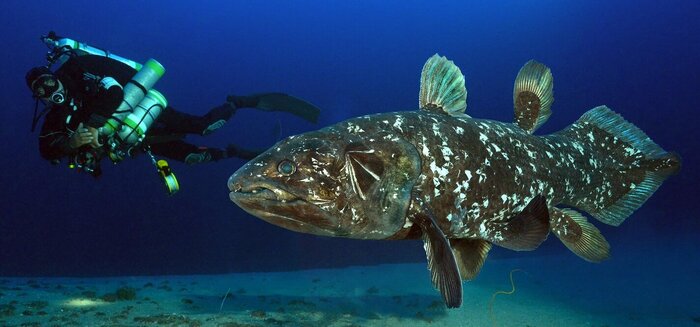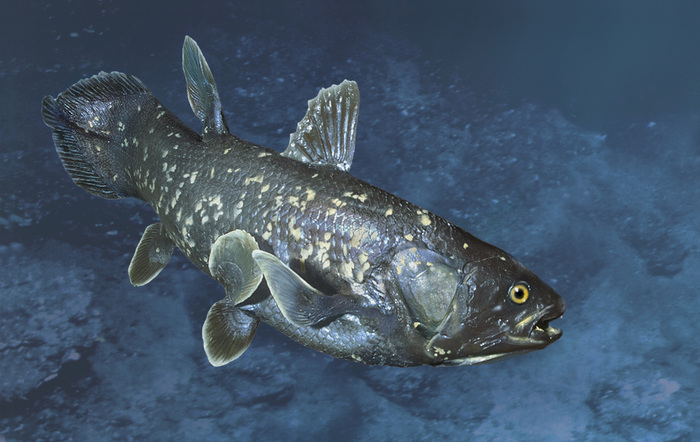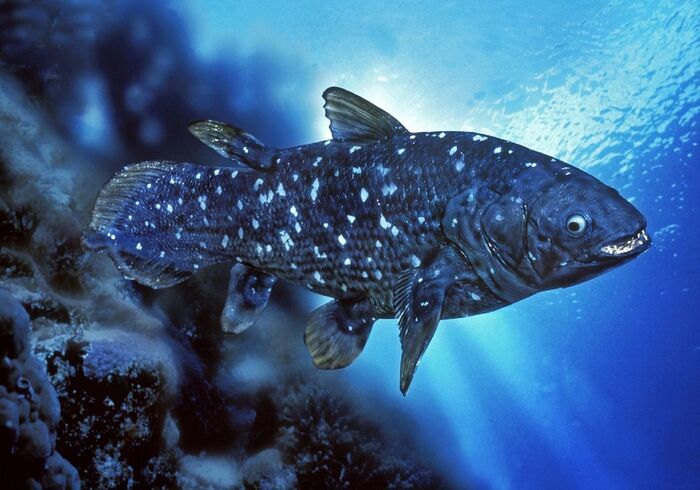The Coelacanth(order Coelacanthiformes) is often referred to as a “living fossil,” Well-represented in both freshwater and marine fossils since the Devonian,a testament to its remarkable survival across millions of years. This ancient fish, once believed to be extinct, provides critical insight into the evolution of vertebrates and the early colonization of land by animals. Below, we explore the Coelacanth's taxonomy, unique features, distribution, behavior, and conservation efforts to understand its significance in the world of science and nature.

The Coelacanth belongs to the order Coelacanthiformes, a group of fish known for their lobe-like pectoral fins. These fins are believed to be the evolutionary ancestors of the limbs of terrestrial vertebrates. The species was once thought to have gone extinct about 66 million years ago, but in 1938, the first living specimen was discovered off the coast of South Africa.
Scientific Name: Latimeria chalumnae (for the species found in the Indian Ocean) and Latimeria menadoensis (for the species found in Indonesia).
Class: Sarcopterygii
Order: Coelacanthiformes
Family: Coelacanthidae
| Rank | Scientific Classification |
|---|---|
| Kingdom | Animalia |
| Phylum | Chordata |
| Class | Actinopterygii |
| Order | Coelacanthiformes |
| Family | Latimeriidae |
| Genus | Latimeria |
| Species | Latimeria chalumnae (West Indian Ocean Coelacanth) |
| Latimeria menadoensis (Indonesian Coelacanth) |
The Coelacanth is a unique species with several features that distinguish it from most other fish:
Physical Appearance: Coelacanths have a robust, thick body with a distinct lobed tail, often referred to as a "prehistoric tail" because it resembles the tail structure of early land vertebrates.
Size: Adult Coelacanths can grow up to 2 meters (6.6 feet) in length and weigh around 90 kilograms (200 pounds).
Body Features: Their scales are thick and shiny, providing protection. Coelacanths have a large, three-lobed tail that helps them move in an undulating motion, unlike most fish that use a more streamlined method of propulsion.
Lobed Fins: One of the key distinguishing features is their lobed pectoral fins, which are thought to resemble the precursor limbs of land-dwelling vertebrates.
Coelacanths are deep-sea dwellers, primarily found in the Indian Ocean and off the coasts of Indonesia and South Africa. They inhabit depths of around 150 to 700 meters (500 to 2,300 feet). These fish are particularly known for their preference for underwater volcanic slopes and ridges.
Geographical Range: Known populations are mainly located in the Comoros Islands near Madagascar, as well as in Indonesia.
Habitat Preferences: They are typically found near the continental slopes, caves, and canyons, where they shelter from predators and feed on smaller fish and invertebrates.
Coelacanths are solitary creatures with fascinating behavioral traits that set them apart from many other fish:
Diet: Coelacanths are carnivorous and feed on deep-sea fish, crustaceans, and cephalopods. They are opportunistic predators, relying on their slow, stealthy movements to ambush prey.
Metabolism: Coelacanths have a slow metabolism, allowing them to survive in low-energy, oxygen-poor environments where other predators might struggle to thrive.
Swimming: They swim in a unique, slow, undulating motion, propelled by their paired pectoral fins, similar to the movement of early tetrapods (four-legged animals).
While Coelacanths are not known to migrate long distances like some fish, they do exhibit specific patterns related to feeding and reproductive cycles:
Movement: They are generally thought to have a small range of movement, staying within specific habitats and caves. Their slow-moving nature and reliance on deep-sea environments limit their exposure to migratory pressures.
Depth Range: Coelacanths are more likely to move to different depths as part of their foraging and mating behaviors, typically shifting between 200-500 meters during the day and night.
Coelacanths are not particularly social animals. They exhibit solitary behavior, spending most of their time resting in caves or crevices during the day and becoming more active at night:
Solitary Nature: They tend to avoid contact with other Coelacanths, often found alone or in small groups.
Breeding and Communication: Communication between Coelacanths is not well understood, though it is believed that their interactions are limited to mating or territorial behaviors.
The Coelacanth is an opportunistic predator, relying on its keen senses to locate prey in the dim depths of the ocean:
Ambush Predators: Using their slow-moving pectoral fins, Coelacanths ambush prey such as fish, squid, and crustaceans.
Feeding Mechanism: Their large, powerful jaws allow them to grab and swallow prey whole. They have highly sensitive electroreceptors in their head, enabling them to detect the movements of prey.
The reproductive behavior of Coelacanths is as unique and fascinating as the species itself. Here’s a detailed look at the reproduction of Coelacanths, including their ovoviviparous nature, embryonic development, and mating patterns.
Coelacanths are ovoviviparous, meaning that after fertilization, the female retains the eggs within her body, where the embryos develop. The gestation period for Coelacanths is unusually long, lasting up to five years. This is one of the longest gestation periods among vertebrates. The embryos grow inside the female’s body and are nourished by the yolk sac, a typical feature of ovoviviparous animals.
Egg Development: The eggs of Coelacanths are large and have only a thin layer of membrane to protect them. This is in stark contrast to the heavily protected eggs of many other fish species.
Birth Process: The embryos hatch while still inside the female’s body, and they are born alive. This live birth is relatively rare among fish species, adding to the Coelacanth’s uniqueness.
Discovered Pregnancy: The first instance of pregnant Coelacanths was discovered in 1975 when scientists at the American Museum of Natural History dissected a specimen and found it carrying five embryos.

Coelacanths exhibit sexual dimorphism, with females being generally larger than males. This size difference is a common trait in many species, often linked to reproductive roles and the need for more space to carry offspring.
Male Anatomy: Male Coelacanths lack distinct copulatory organs. Instead, they possess a cloaca, a common opening for excretion and reproduction. The cloaca contains a urogenital papilla surrounded by erectile caruncles, which may be involved in the mating process.
Hypothesis on Copulation: It is hypothesized that during copulation, the cloaca everts to act as the copulatory organ, allowing for the transfer of sperm to the female’s reproductive tract.
The embryos of Coelacanths undergo significant development inside the female, eventually hatching as fully developed juveniles.
Embryo Appearance: The embryos resemble the adult form, with notable differences such as a prominent external yolk sac. This yolk sac provides nourishment during the final stages of development.
Juvenile Characteristics: After birth, young Coelacanths display larger eyes relative to their body size, and a more pronounced downward slope of the body. The broad yolk sac hangs beneath the pelvic fins, and the scales and fins of the juvenile are fully matured at birth. However, they lack odontodes (tooth-like structures), which they develop later during maturation.
A study examining the paternity of Coelacanth embryos has provided insights into their mating system. The study found that in two different females, all embryos in a single clutch were sired by a single male. This suggests that Coelacanths may practice monandry, where females mate with only one male during a reproductive cycle.
Monandry vs. Polyandry: In contrast, polyandry, where a female mates with multiple males, is common in both animals and plants. Polyandry can be beneficial in some contexts, such as ensuring genetic diversity and preventing infertility from a single male. However, it also has costs, such as:
Increased risk of infection from multiple mating encounters.
Greater predation risk when searching for multiple mates.
Higher energy costs for the female during the mating process.
The evidence pointing to monandry in Coelacanths suggests that females may benefit from reduced risks and energy expenditure by mating with a single male. However, more research is needed to understand whether Coelacanths occasionally engage in polyandry, especially in response to environmental pressures or mate availability.
The reproduction of Coelacanths remains one of the most fascinating aspects of this ancient fish. Their long gestation period, live birth, and unique reproductive anatomy set them apart from most other species. Although much about their mating system is still under study, the current evidence suggests a possible preference for monandrous mating, though polyandry could still be part of their reproductive strategy under certain circumstances.
These incredible adaptations not only make Coelacanths a living link to ancient evolutionary history but also provide essential insights into the reproductive strategies of one of the ocean’s most enigmatic creatures.
The Coelacanth is classified as Critically Endangered (CR) by the International Union for Conservation of Nature (IUCN). Their populations are at risk due to several factors:
Habitat Destruction: Deep-sea mining, pollution, and human activities have altered their natural habitat, leading to population declines.
Overfishing: Although Coelacanths are not typically targeted for commercial fishing, bycatch and accidental capture in nets have been significant threats.
Slow Reproduction: Their slow reproductive rate makes it difficult for populations to recover from population declines.
Current estimates suggest that there are only a few hundred Coelacanths remaining in the wild. Populations are generally confined to a few isolated regions, including the Comoros Islands and parts of Indonesia. Given their slow reproduction rate and the vulnerability of their habitats, these fish face a high risk of extinction if current threats are not mitigated.
There are two known species of Coelacanths in existence today, both of which are from the genus Latimeria. They are distinguished by their geographic distribution and minor physical differences. Below is a table showcasing the two primary species of Coelacanth:
| Species Name | Common Name | Geographic Range | Discovery Year | Habitat Depth | Conservation Status | Key Features |
|---|---|---|---|---|---|---|
| Latimeria chalumnae | West Indian Ocean Coelacanth | Found off the coast of South Africa, Mozambique | 1938 | 150 to 700 meters deep | Endangered | Larger size, darker blue-gray color, discovered first in 1938 |
| Latimeria menadoensis | Indonesian Coelacanth | Sulawesi waters, Indonesia | 1997 | 150 to 200 meters deep | Critically Endangered | Smaller, lighter color with more distinct fins, discovered later in 1997 |
Latimeria chalumnae (West Indian Ocean Coelacanth)
Geographic Range: This species is primarily found around the coastal waters of South Africa and Mozambique in the Indian Ocean.
Discovery Year: First discovered in 1938 by Marjorie Courtenay-Latimer, this species became one of the most famous examples of a "living fossil."
Size and Features: Typically, these Coelacanths are larger than their Indonesian counterparts, reaching sizes of up to 2 meters in length. They have a darker blue-gray coloration and more prominent scales.
Habitat: They live at depths ranging from 150 meters to 700 meters, inhabiting underwater volcanic slopes and caves.
Conservation Status: Endangered, with only a few confirmed populations, which makes conservation efforts crucial.
Latimeria menadoensis (Indonesian Coelacanth)
Geographic Range: Discovered off the coast of Sulawesi, Indonesia in 1997, this species is known to live in a more restricted range compared to Latimeria chalumnae.
Discovery Year: The discovery of this species came nearly 60 years after the first Coelacanth was found. It was reported by a local fisherman and identified by researchers.
Size and Features: This species is somewhat smaller than Latimeria chalumnae, typically reaching lengths of about 1.5 meters. It has a lighter coloration with more distinct fins.
Habitat: This species tends to inhabit depths of around 150 to 200 meters, living in deeper, rockier parts of the ocean near underwater volcanoes.
Conservation Status: Critically Endangered, with only a few sightings and a low population, making it more vulnerable than its relative.
Both Latimeria chalumnae and Latimeria menadoensis represent unique and endangered species that have survived for over 400 million years, maintaining features from an ancient time in evolutionary history. Their rarity, specialized habitat, and ancient lineage make them critical subjects for scientific study and conservation.
The Coelacanth faces minimal natural predation due to its deep-sea habitat. However, the primary threats come from human activities:
Bycatch: Coelacanths are occasionally caught in deep-sea fishing nets, which poses a significant threat to their survival.
Habitat Degradation: Pollution, deep-sea mining, and coastal development have degraded the Coelacanth’s habitat, making it harder for them to find suitable areas for feeding and reproduction.
Conservation efforts for the Coelacanth are ongoing and primarily focus on protecting its habitat and minimizing human impact:
Marine Protected Areas (MPAs): Efforts have been made to establish MPAs around known Coelacanth habitats to reduce the risk of bycatch and habitat destruction.
Research and Monitoring: Scientists are working to better understand the Coelacanth’s behavior, reproductive cycle, and habitat needs in order to inform more effective conservation strategies.

As a "living fossil," the Coelacanth plays a critical role in our understanding of evolutionary biology. By studying this species, scientists gain insights into the transition from aquatic to terrestrial life forms:
Evolutionary Significance: The Coelacanth's lobed fins are considered an important evolutionary link between fish and the first land-dwelling vertebrates.
Biodiversity: Protecting the Coelacanth helps maintain biodiversity in the ocean's deep ecosystems, ensuring the survival of unique marine species.
Cultural Importance: The Coelacanth has fascinated scientists and the general public alike, symbolizing mystery and survival. It plays a role in local folklore and is an icon of scientific discovery.
Economic Impact: While the Coelacanth itself is not a commercial species, its discovery has contributed to tourism in the Comoros Islands and other coastal regions. It has become a symbol of marine conservation.
Due to their critical conservation status, Coelacanths are not targeted for commercial fishing. However, their accidental capture as bycatch in deep-sea trawl fisheries does occur occasionally.
Catch and Trade: The trade of Coelacanths is heavily regulated, with international protection efforts to prevent their capture or sale.
The Coelacanth is a species that continues to captivate the imagination of scientists and the public alike. Its unique evolutionary traits and importance in the history of life on Earth make it a fascinating subject of study. Despite the challenges it faces, ongoing conservation efforts give hope that this ancient fish will continue to thrive in the deep oceans for years to come. By understanding and protecting the Coelacanth, we preserve a piece of natural history and safeguard the biodiversity of our planet’s oceans.
animal tags: Latimerioidei
We created this article in conjunction with AI technology, then made sure it was fact-checked and edited by a Animals Top editor.